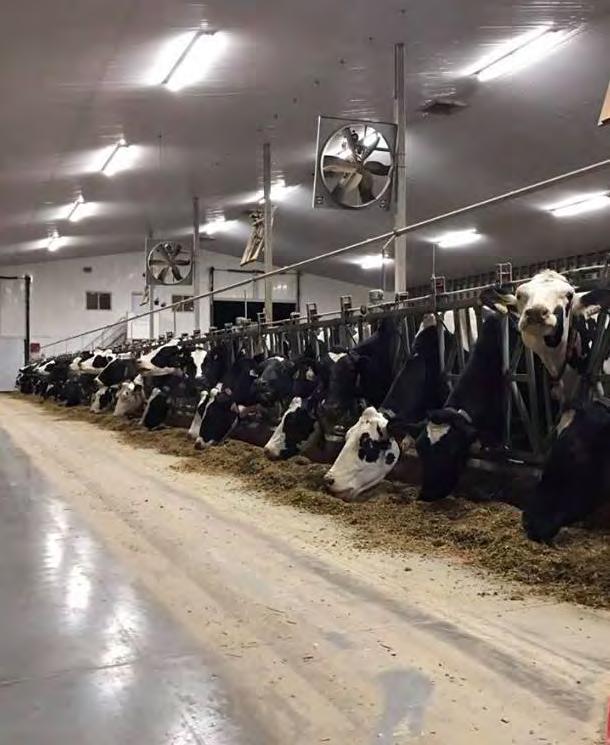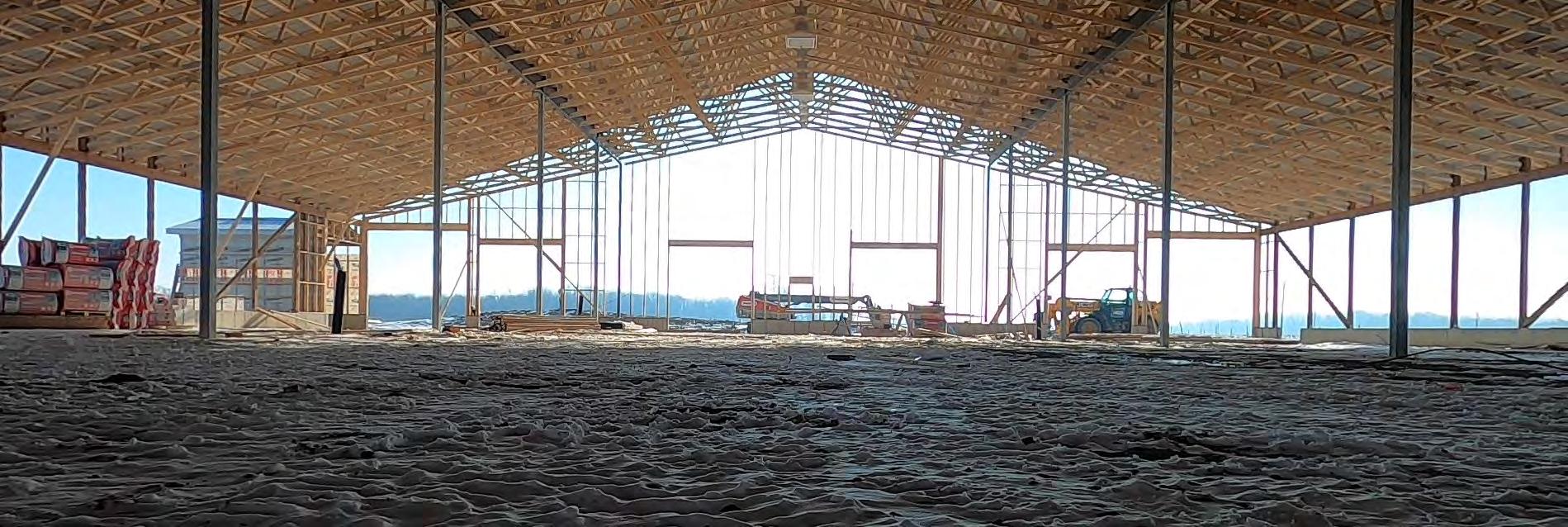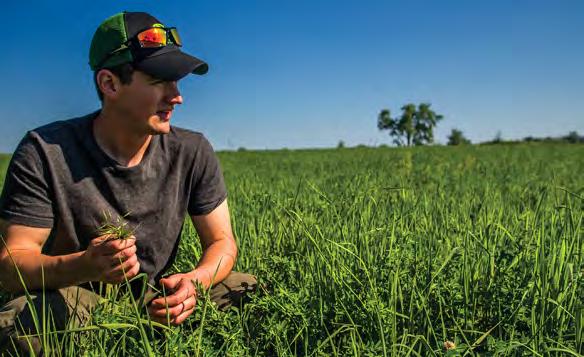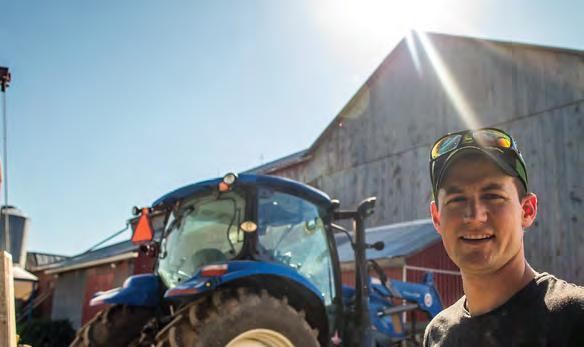
9 minute read
Digital dairy farming
from 2022-Early Spring
by MilkProducer
Dairy farms today are increasingly using robots, artificial intelligence, data-driven techniques and other farm management software to increase efficiency and improve cow health.
By Trudy Kelly Forsythe CONTRIBUTOR
Jack Rodenburg, a dairy management consultant with Dairy-
Logix, has seen a lot of technological changes and improvements during his career. He says when robotics, specifically ....robotic milking, first came along, the industry was concerned farmers would have less ability to manage animal health without the personal contact and close observation one is able to get during milking. As a result, early developments built in a lot of checks and balances and sensor-driven information to compensate for that.
“From the beginning, all robotic milking systems included information about milk conductivity and information about milk colour as a substitute for the farmer squeezing that first strip of milk out of the teat at the start of milking,” he says, adding robots today give substantially better data at every milking than earlier versions.
In the past decade, a big shift has been the improved functionality of wearable technologies and in-line milking analysis systems, primarily because battery capacity has greatly improved.
“We worked a fair bit with pedometers and devices that had to be read in the milking parlour and one of the reasons for that was because battery life was an issue,” Rodenburg says. “Because of developments in other industries, our batteries have gotten 10 times better in the last 10 years, so now pretty much all that technology has shifted to signaling receivers located throughout the barn so you can get a lot more real-time information.”
One area this is quite helpful with is reproduction. Since cows in heat are more active, and tend to not voluntarily go to the milking robot, the activity pedometers provide data to farmers earlier than the robotic milker would.
“The system knows that cow is in heat, but you don’t if you don’t get a readout until she goes into the milking system,” Rodenburg says. “In the robotic milking applications, the systems that can pick up data in real time throughout the barn have proven to be a substantial improvement.”
The same sensor can flag when a cow may be sick, although Rodenburg says this technology is in its infancy and needs to be improved.
“We have new technology coming out that will measure inner ear temperature or internal temperature with a bolus that’s in the rumen, but very few of them have been picked up by mainstream milking equipment companies at this point,” he says, adding he sees a bright future for when it does make its way into dairy barns.
There is also potential in feed preparation and feed delivery, the second largest labour factor on a dairy farm after milking. The big challenge, however, is maintaining feed quality since feed is moved from storage into the system.
“Most of the bigger dairies store their feed in bunker silos or piles and these robotic systems don’t really have the capability of removing that from the silo,” Rodenburg says. “When you do that, you loosen the material and then it gets exposed to air and you run the risk of spoilage from that point on.”
People are taking different approaches to deal with this issue, and more adoption of automatic feeding systems is expected in the future.
Rodenburg is hopeful the advances being made with automation and sensor-based technology will benefit smaller operations as well as larger ones.
“When we were dealing with just mechanization technology, things like milking parlours and total mixed ration mixers, everything was always about bigger because bigger is what made those investments financially feasible,” he says. “I think this makes it possible for a family-run dairy to be much more sustainable and economically viable than the earlier technologies did.”
Dairy farming has become increasingly digital since farmers installed the first robotic milkers in the late 1990s.
These days, it’s not unusual to find dairy farmers using automatic feeders, artificial intelligence, data-driven techniques, farm management software and smartphones, to better manage their farms and improve cow health and welfare.
Holmdale Farms
increasing efficiency and improved cow health
Holmdale Farms in Elmwood, Ont., is one of those farms. Operating since 1874, the farm had one of the first rotary milking parlours installed in Canada in 1974 to improve efficiency. It has since been upgraded to a robotic milker and now has robots that also clean the barn and feed the cows and calves.
Todd Holm, a fifth-generation farmer who operates the farm with his wife, children and two employees, says the robots have changed everything for the farm and the way it’s run.
“We have a lot more efficiency, a lot more data, a lot more individual management of animals instead of treating everything as a herd,” he says, adding the farm’s robotics take the place of two employees, an important task given the challenge of finding farm labour. “No one is available and the industry can’t carry on with no people to hire.”

At Holmdale Farms, while the cleaning and collecting robot keeps the barn clean, the calf program feeding robot feeds milk to calves at the times they need it. On the other hand, the robotic milker milks the cows when they want to be milked. It also monitors cow health, weight and milk production and gives each cow a specific amount of grain based on their individual milk production.
“The lower (cow) producers aren’t getting waste and the higher producers are getting what they need,” Todd says. “It helps with their health a lot.”



CAMPBELL FAMILY, from left are Jess, Bella, Cash and Andrew who continue to progress with their farm automation. Above photo shows their current new barn construction.
TECHNOLOGY HAS enabled the Campbells to increase crop yields while reducing their labour costs.


The Campbell Family
has joined the digital revolution
Andrew Campbell, Bellson Farms, is a fifth-generation farmer in southern Ontario’s Middlesex County where he and his family milk cows and grow corn, soybeans, wheat and hay.
The Campbell family is currently building a new freestall barn to replace their tiestall one that will incorporate various improvements such as a robotic milker, robot calf feeder and robot feed pusher.
While labour savings is one reason for the investment, like so many dairy producers making the shift, Campbell says a big reason is the health and welfare benefits for their cows.
“I’m quite excited to see how it goes in terms of the ability for the cow to decide her own schedule, rather than it being up to us whether she gets milked two times a day, three times a day or at specific times,” Campbell says, adding he is also excited about the software that will allow them to analyze trends.
“That way, we have a combination of all the data points from movement to eating to milking to milk quality,” he says, explaining the information the robot provides will let them know if everything is okay, out of the ordinary or needs immediate attention.
Campbell is confident the upgrades will contribute to improvements in animal health and welfare.
“I think they’re going to be amazing,” he says. “This technology is going to help us be even faster at detecting problems and getting cows on the path to recovery because we will know as soon as she slows down in movement or milk production.”
Campbell is also adding a system that will automate the barn’s ventilation and lighting to help control temperature and lights based on more than time of day, making the farm more energy efficient and the cows more comfortable.
“It’s a big investment, but it’s one that is going to build our future in the dairy industry, as well as be a pretty good place to be a cow in,” he says.
THE NEED FOR HIGH SPEED INTERNET
Access to high-speed internet has long been a challenge in rural communities and, as dairy farms become more digital, that need becomes even greater.
Dairy management consultant Jack Rodenburg explains with the amount of data going into computers on the farm, how they interact with computers on other sites is going to influence how dealers can work with farmers.
He gives examples of farms working with off-site nutritionists who need adequate speeds to view herd performance in terms of an individual cow’s eating behaviours, and equipment dealers who need to troubleshoot and examine maintenance requirements by remotely monitoring performance in robotic milking systems.
“Those things will all get better and easier if we have good internet connections,” Rodenburg says.
Both federal and provincial governments are working together to address the issue. Last July, both governments announced investments to support large-scale, fibre-based projects to bring highspeed internet to nearly 280,000 rural Ontario households by 2025.
Like many in rural communities, dairy farmers Todd Holm, in Elmwood, Ont., and Andrew Campbell, in southern Ontario’s Middlesex County, are both waiting for high-speed internet to reach their farms.
“We have a lot of advisers and technicians on computers trying to keep us more efficient and right now they get frustrated with the slow connection and getting booted off the system,” Holm says. “We could do a lot more with better internet.”
Campbell is in a similar situation. “The (internet) speed definitely holds us back from being able to really utilize the cloud as much as we’d like to,” he says. “I think faster internet days are ahead and I look forward to it, but it’s not quite here yet.”
- Todd Holm
Trudy Kelly Forsythe
is an award-winning contributor to many publications in Canada and beyond, specializing in business and technology issues in the sectors of agriculture, food, manufacturing and more.

—Remco Brinke, Owner of Lintfield Farms


519-229-6108
toews@compassenergyconsulting.ca
www.toewspower.com www.compassenergyconsulting.ca





